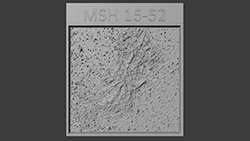CXC Home | Search | Help | Image Use Policy | Latest Images | Privacy | Accessibility | Glossary | Q&A
1
X-ray, Radio, and H-alpha Images of MSH 15-52Credit: X-ray: NASA/CXC/Univ. of Hong Kong/S. Zhang et al.; Radio: ATNF/CSIRO/ATCA; H-alpha: UK STFC/Royal Observatory Edinburgh; Image Processing: NASA/CXC/SAO/N. Wolk
Near the center of these images lies the pulsar B1509-58, a rapidly spinning neutron star that is only about 12 miles in diameter. This tiny object is responsible for producing an intricate nebula (called MSH 15-52) that spans over 150 light-years, or about 900 trillion miles. The nebula, which is produced by energetic particles, resembles a human hand with a palm and extended fingers pointing to the upper right in Chandra’s X-ray view. Radio data from ATCA provides new information about this exploded star and its environment. This image also contains optical data of hydrogen gas. The bright red and gold areas near the top of the image show the remains of the supernova that formed the pulsar.
2
3D Printable Files: MSH 15-52(3D Print Credit: NASA/CXC/A. Jubett, using software by Tactile Universe/N. Bonne & C. Krawczyk & Blender)
This tactile plate features a composite image of MSH 15-52, a nebula and pulsar that resembles a cosmic hand reaching for a cloud. Chandra’s X-ray view is combined with radio data from ATCA, as well as optical data of hydrogen gas. A cloud sits near the top of the plate, just to our right of center. Breaks in the cloud reveal interwoven strands like a latticework substructure. The cloud is the remains of the supernova that formed the pulsar at the heart of the image. The pulsar, a rapidly spinning neutron star only 12 miles in diameter, is far too small to be seen in this image, which represents a region of space over 150 light-years across. The bottom half of the plate is dominated by a massive hand reaching up toward the pulsar and supernova cloud. The hand and nebula are set against the blackness of space, surrounded by scores of specks. At our lower left, a hydrogen gas cloud extends beyond the edges of the image.
Return to: X-ray, Radio Go 'Hand in Hand' in New NASA Image (August 20, 2025)









